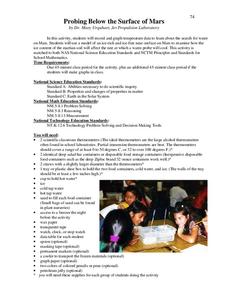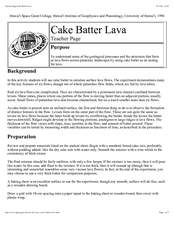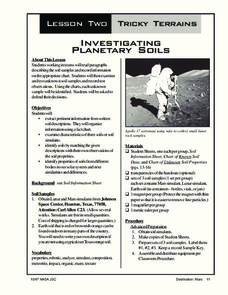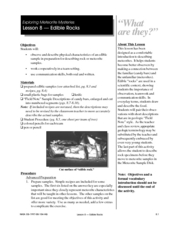NASA
Measuring Solar Energy During an Eclipse
Don't leave your classes in the dark! An inquiry-based lesson has young researchers analyze the light intensity before, during, and after a solar eclipse. They use their data to make inferences about the solar energy available during...
NASA
Soda-Straw Rockets
Launch a great lesson exploring engineering design. Using a template, young scholars create rockets that can be launched from a straw. After analyzing the function of the rocket, pupils try to modify the rocket to enhance its function.
NASA
Art and the Cosmic Connection
Solar art inspires! Scholars study planetary geology with an artistic analysis. Pupils view a PowerPoint presentation on the solar system and space exploration and then try their hand at planetary image analysis using art techniques.
Curated OER
Creating Impact Craters
Sixth graders simulate the creation of impact craters on Mars.Through the creation of model surfaces, the effects of an impacting object's mass, velocity and size are determined, and the features of the resulting crater are identified.
Curated OER
Interplanetary Travel Guide
In groups of six, middle school space scientists create an imaginative travel brochure for attracting visitors to the planet Mars. Information must include surface features and atmospheric conditions. Although time-consuming, this is a...
Curated OER
Clouds, Winds, and Weather
Young scholars observe, record, and report weather conditions to learn how air mass densities determine the weather we experience daily. They demonstrate how clouds form, name clouds and predict the weather.
Curated OER
Discovering Saturn, The Real "Lord of the Rings"
Reading, writing, and rings! A lesson from NASA combines space science with authentic reading and writing tasks. Included in this lesson are pre-reading activities, four mini informational booklets on Saturn, a structured...
Curated OER
Rover Races
Students identify the challenges encountered by astronauts in operating a planetary rover. In this space science activity, students create a rover using their team members. They follow a command sequence from the driver and navigate...
Curated OER
Areology-The Study of Mars
Students examine core samples from Mars and discover what they can use it to tell the history of Mars. In this core sample lesson students create and analyze their own core samples then eat them at the end.
Curated OER
Probing Below the Surface of Mars
Learners simulate the search for water in Mars using simple apparatus. In this space science activity, students explain how soil temperature affects the cooling of probes. They graph the data collected from the simulation.
Curated OER
Cake Batter Lava
Students examine how lava flows change the landscape. In this lava lesson students complete a lab activity where they create a lava flow using cake batter.
Curated OER
Regolith Formation
Students study what regolith is and how it contrasts with weathering on Earth. In this weathering lesson students divide into groups, hypothesize and confirm their guesses.
Curated OER
Impact Craters: Holes in the Ground!
Young scholars simulate crater formation through a lab activity. In this space science instructional activity, students calculate how much energy is transferred during meteorite impact. They identify different factors affecting the size...
Curated OER
Is There Liquid Water on Mars?
Students assess whether there is liquid water on Mars by analyzing images and data. In this planetary lesson students analyze temperature and pressure graphs and hypothesize about how water could have flowed on Mars.
Curated OER
Investigating Planetary Soils
Students study soil characteristics and identify properties of soils from different parts of the solar system. For this soil lesson students divide into groups, read soil descriptions, test and record soil samples.
Curated OER
Changes Inside Planets
Students relate meteorites to the mantle and crust of asteroids. In this planetary instructional activity students complete experiments to model the separation of light.
Curated OER
Making a Comet in the Classroom
Young scholars study comets and how Halley's comet was created. In this space lesson students create their own comets using dry ice.
Curated OER
Make a Comet Model and Eat It!
Students construct a comet model based on procedure provided. In this space science lesson plan, students compare the physical properties of comets to the models they made. They record their observations and share them with the class.
Curated OER
Searching for Meteorites
Students examine meteorites and attempt to recover meteorite fragments. In this space instructional activity students complete a demonstration on the impact of a meteorite using water balloons and make experimental predictions.
Curated OER
Follow the Falling Meteorite
Middle schoolers use triangulation method to locate meteorite landing site on the map. In this earth science instructional activity, students participate in a meteorite treasure hunt set up by the teacher. They explain how this method is...
Curated OER
Edible Rocks
Learners create meteorite models using candy bars. In this earth science lesson, students describe the physical features of a meteorite. They sketch it and write a short description about it.
California Academy of Science
Kinesthetic Astronomy: The Meaning of a Year
How many times have you traveled around the sun? Aspiring astronomers grasp what a year is and they differentiate between orbit and rotation by walking around the sun right within your classroom. Place a lamp in the center of the room to...
American Museum of Natural History
Planetary Mysteries
Get to know our little part of the vast universe. Learners read about the common and not-so-common facts about each of the planets in the solar system. The interactive lesson includes a large amount of information as well as a quiz to...
EngageNY
Interpreting the Graph of a Function
Groups sort through NASA data provided in a graphic to create a graph using uniform units and intervals. Individuals then make connections to the increasing, decreasing, and constant intervals of the graph and relate these...























